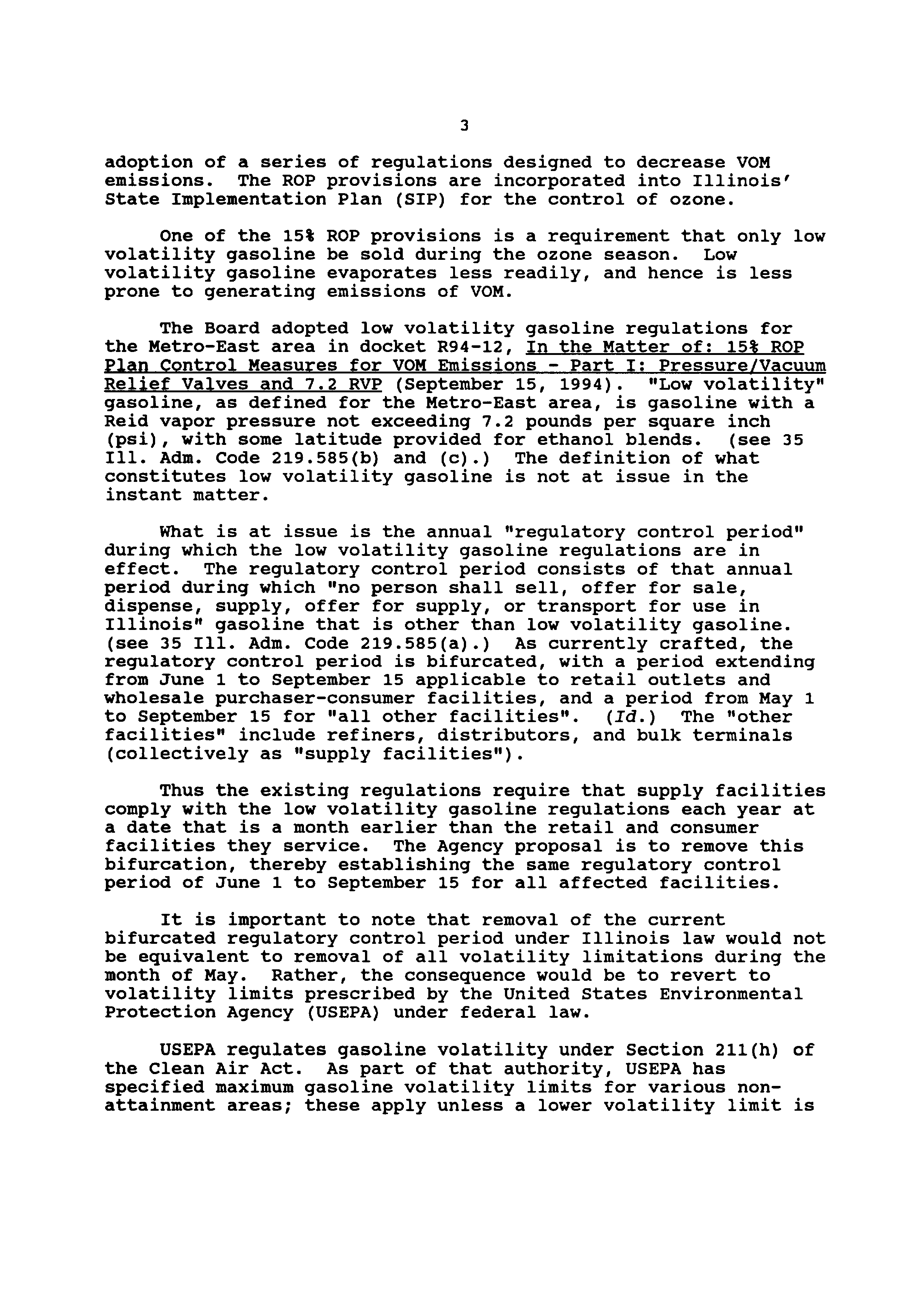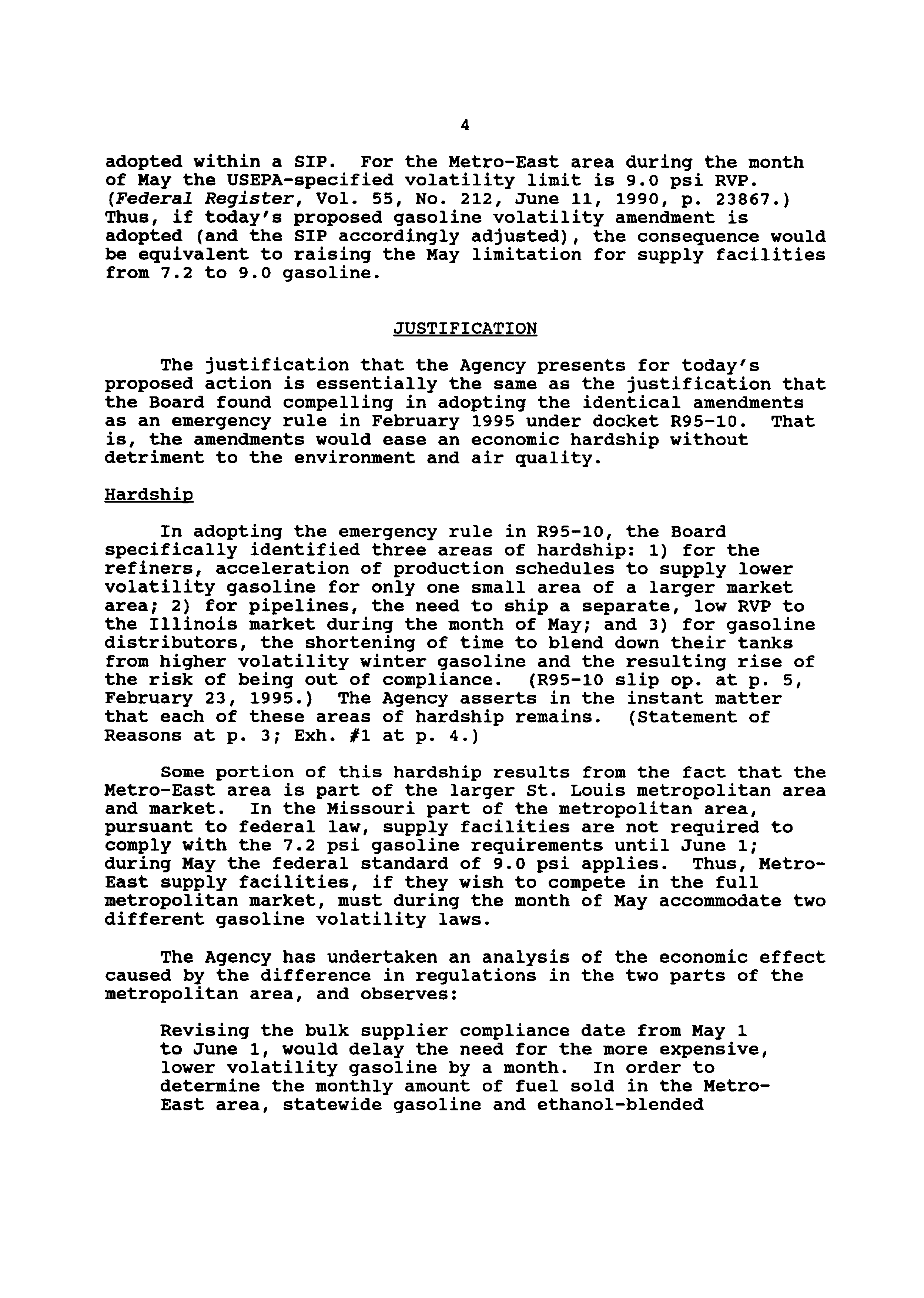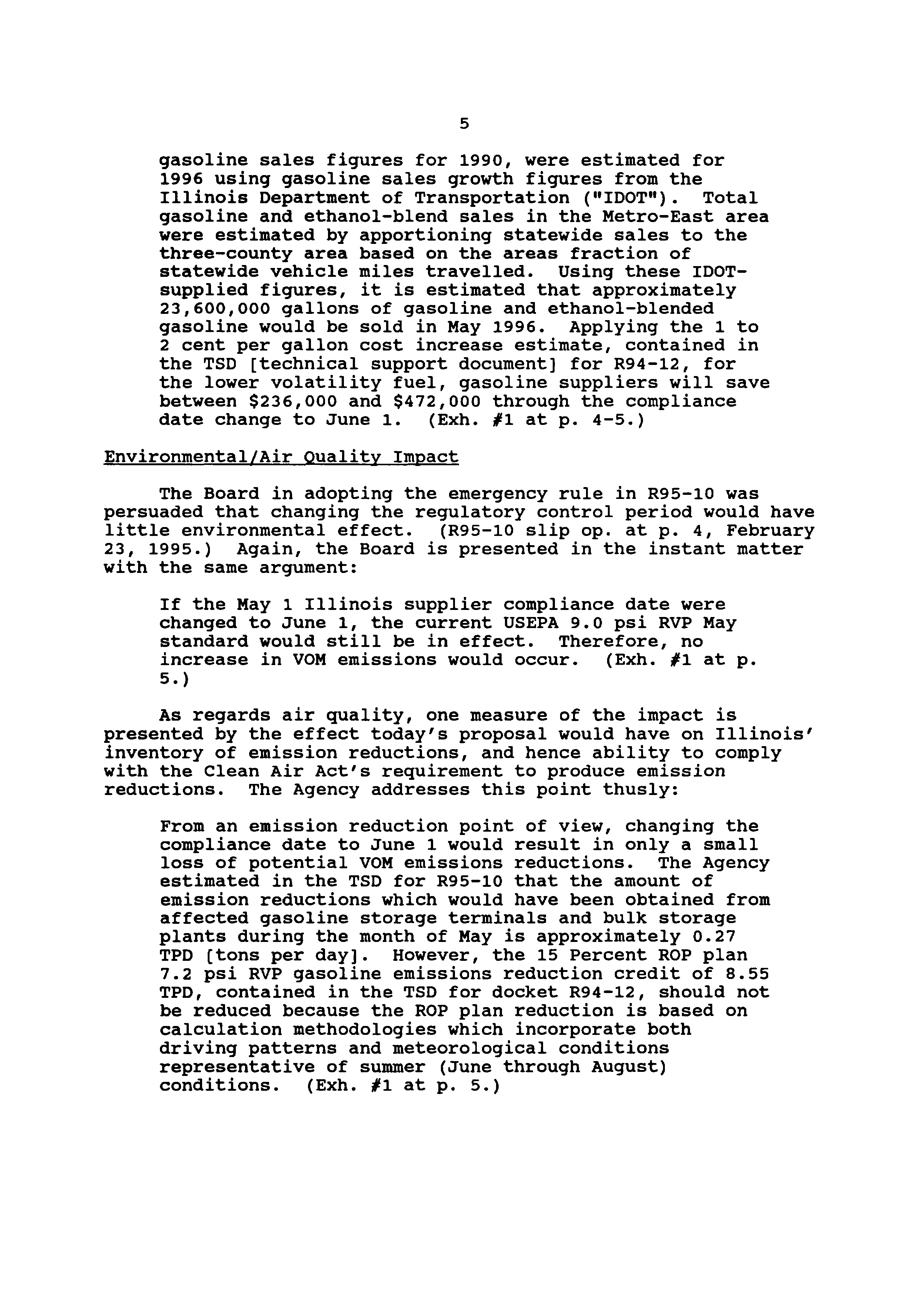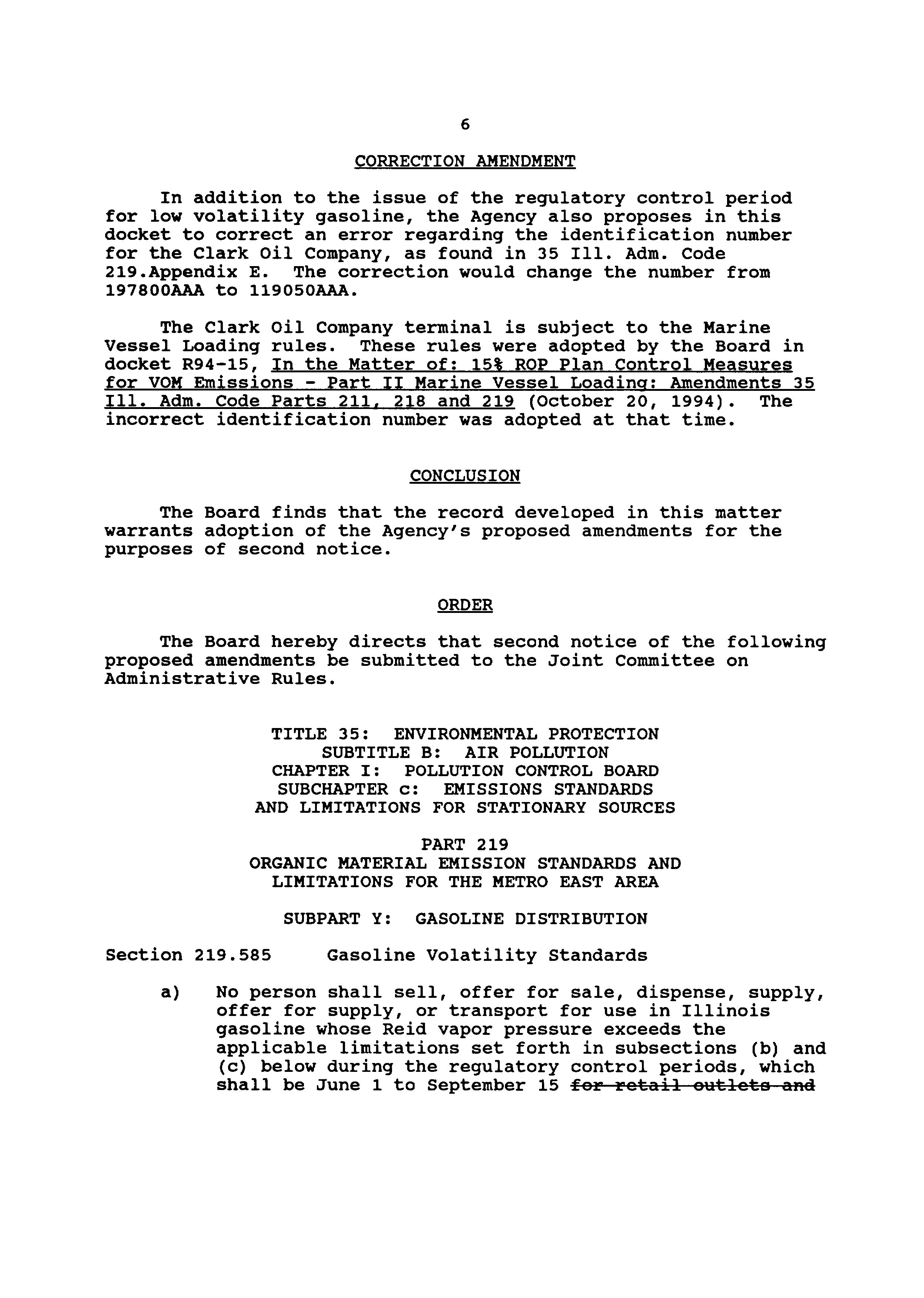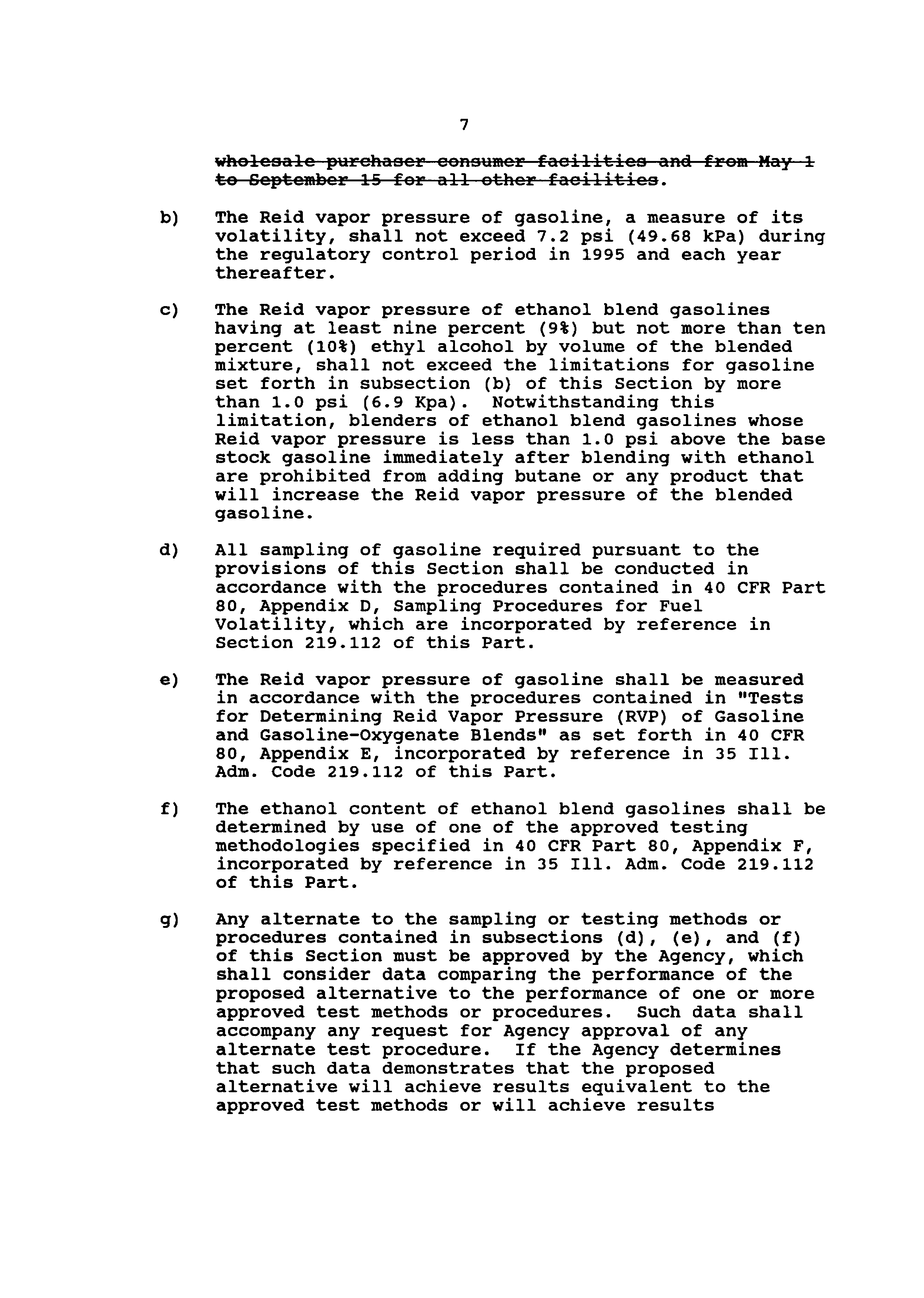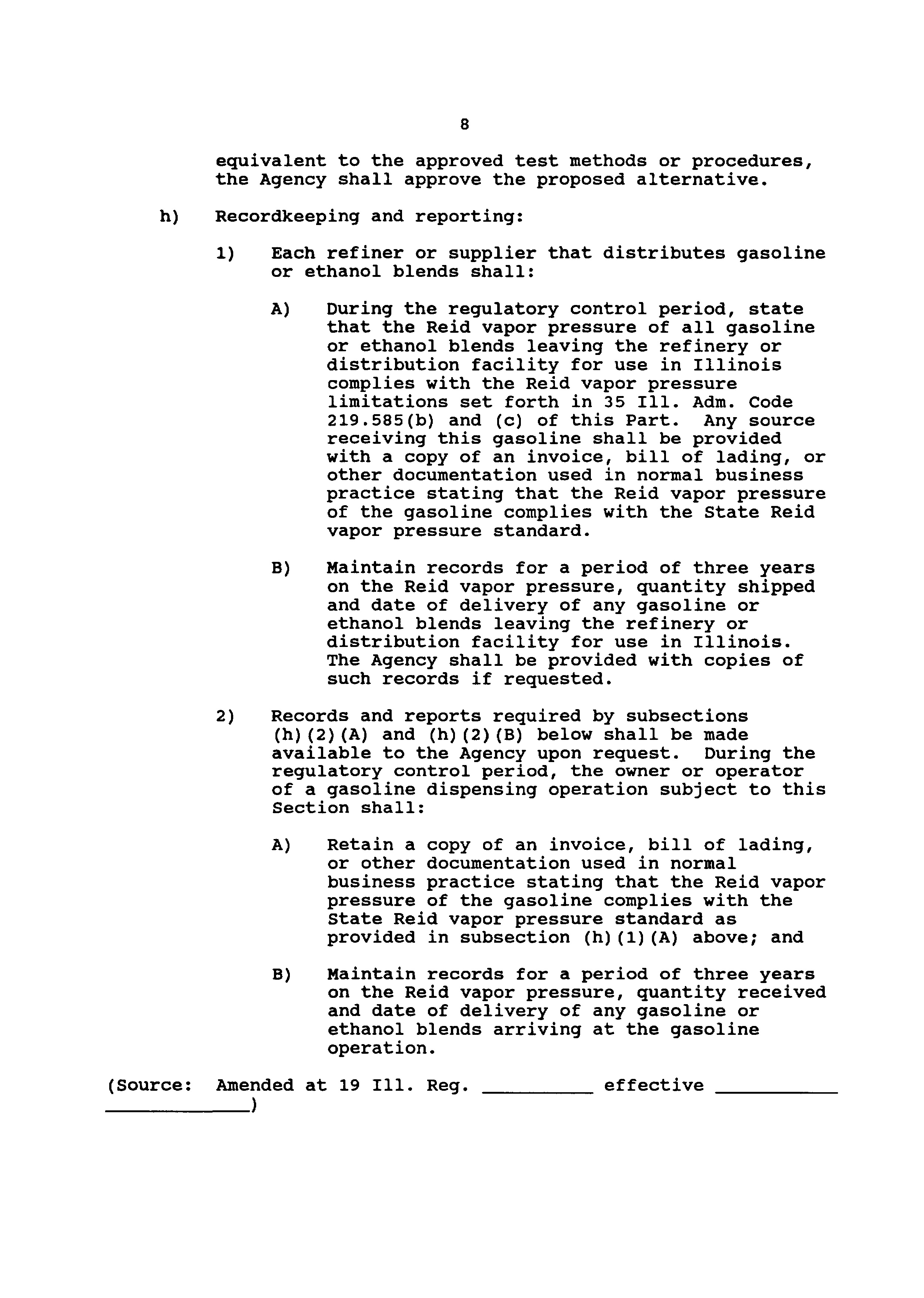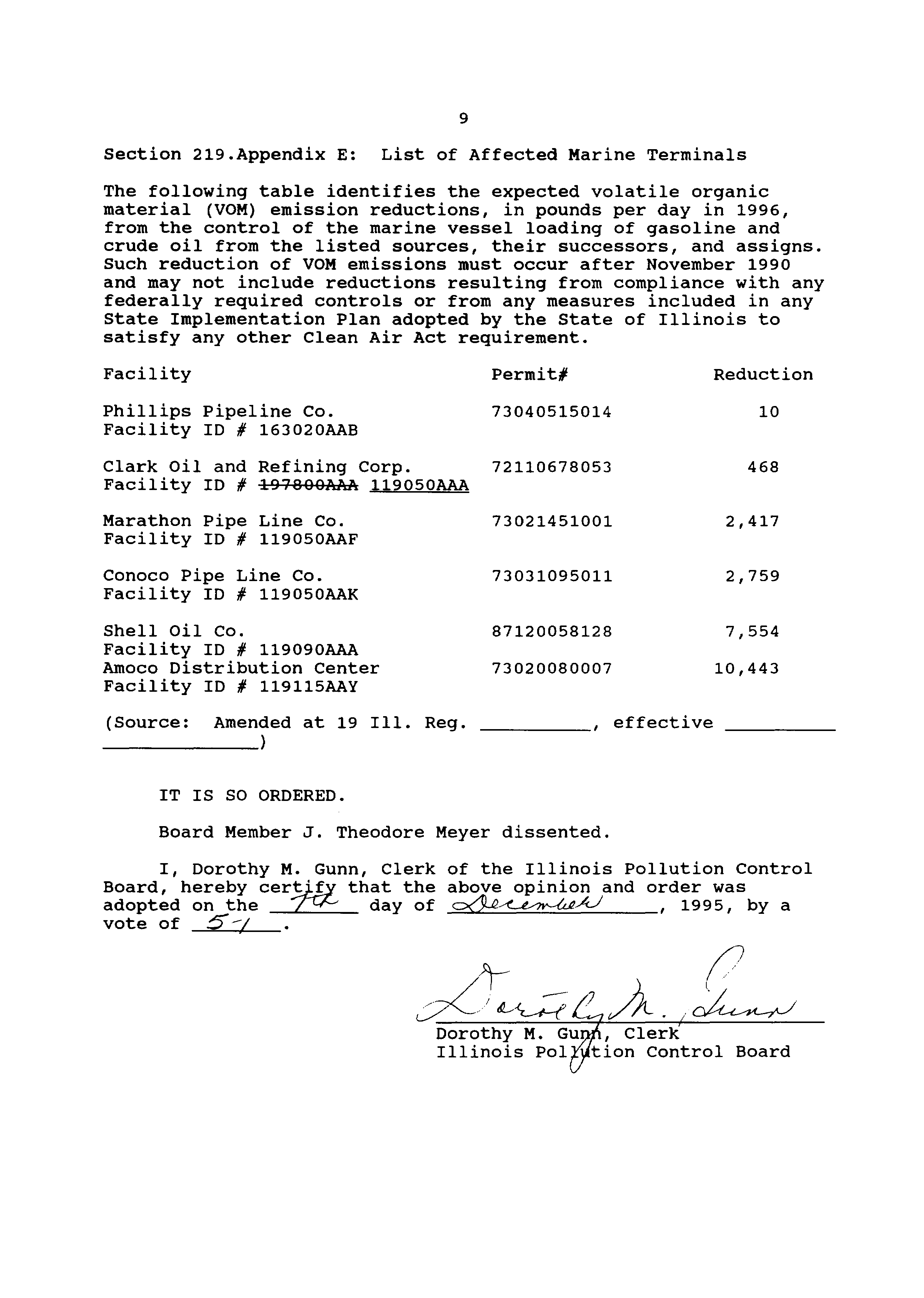ILLINOIS POLLUTION CONTROL BOARD
December
7,
1995
IN THE MATTER OF:
)
)
15
ROP PLAN: CLEAN-UP PART I
-
)
R96-2
AMENDMENTS TO 35
ILL. ADM. CODE
)
(Rulemaking
-
Air)
219.585(a)
AND
219.APPENDIX E
)
Prolosed Rule.
Second Notice.
OPINION
AND
ORDER OF THE BOARD
(by R.C.
Flemal):
This matter comes before the Board upon a petition for
rulemaking filed by the Illinois Environmental Protection Agency
(Agency).
The Agency requests that the Board make two amendments
to its air emissions regulations applicable in the Metro—East St.
Louis areas
(Madison, Monroe,
and St. Clair Counties).
The
principal amendment would establish a uniform annual date of
June
1 upon which all regulated gasoline facilities must comply
with 7.2 psi Reid vapor pressure
(RVP)
gasoline requirements;
currently the June 1 date applies to retail outlets and wholesale
purchaser—consumer facilities, whereas the date of May
1 applies
to other facilities
(i.e., refiners, distributors, bulk
terminals).
The second proposed amendment is a housekeeping
matter that would correct an error in the identification number
of a marine terminal at 35
Ill. Adm. Code 219.Appendix E.
The Board’s responsibility in this matter arises from the
Environmental Protection Act
(Act)
(415 ILCS 5/1 et seq.
(1992)).
The Board is charged therein to “determine, define and implement
the environmental control standards applicable in the State of
Illinois”
(415 ILCS 5/5(b)).
More generally, the Board’s
rulemaking charge is based on the system of checks and balances
integral to Illinois environmental governance: the Board bears
responsibility for the rulemaking and principal adjudicatory
functions; the Agency has primary responsibility for
administration of the Act and the Board’s regulations,
including
the regulations today proposed for amendment.
By today’s action the Board adopts the proposed amendments
for the purpose of second notice, pursuant to the Illinois
Administrative Procedure Act
(5 ILCS 100/1-1 et
seq.
(1994)).
This matter will now be filed with the Joint Committee on
Administrative Rules
(JCAR)
for consideration by that body.
2
PROCEDURAL HISTORY
The Agency filed its petition on September
6,
1995.
The petition was accompanied by a motion to expedite decision.
The Board granted the motion and additionally on September 21,
1995 adopted the Agency’s proposal for the purpose of first
notice.
First notice publication occurred at 19
Illinois
Register
14267 (October 13,
1995).
Hearings were held before hearing officer Audrey Lozuk-
Lawless on October 25,
1995 in Springfield, Illinois, and on
October 26,
1995 in Edwardsville, Illinois.
At both hearings the
Agency presented testimony in support of the proposal.
Testimony
in support of the proposal was also received from Amoco Oil
Company and the Illinois Environmental Regulatory Group.
Shell
Oil Company filed the only public comment and supported the
proposed rulemaking to provide consistency with the USEPA
regulations.
JCAR suggested updates to the source notes which
the Board today incorporates.
The Board observes that the amendment regarding the 7.2 psi
RVP
compliance date has been before the Board on a prior occasion
as the subject of an emergency rule adopted by the Board
in
February 19951; the emergency rule was in effect for the 1995
ozone season.
The current proposal
is,
in effect,
a proposal to
apply that rule on a permanent basis.
The Agency contends,
as it did in the emergency rule
proceeding,
that the uniform June 1 compliance date “is
appropriate at this time in view of the need for consistency
between the Board’s rules and USEPA’s regulations”
(Motion at
¶3), and that the “change should be accomplished as quickly as
possible to address concerns of enforceability of the current
rule”
(Id.).
NATURE OF PROPOSAL
Section 182(b) (1) of the Clean Air Act, as amended in 1990,
requires all moderate and above ozone nonattainment areas to
achieve a 15
reduction of 1990 emissions of volatile organic
material
(VON)
by 1996.
In Illinois, the Chicago and Metro-East
areas are classified as “severe” and “moderate” nonattainment for
ozone, respectively, and as such are subject to the 15
reduction
requirement.
Illinois has met its 15
reduction obligations by
designing a 15
Rate of Progress
(ROP)
plan,
which included
1
In the Matter of: Emeraencv Rule Amending 7.2 isi Reid
Vapor Pressure Reauirement
in the Metro-East Area,
35 Ill. Adm.
~c1e 219.585(a~, R95-10,
adopted by Board order of February 23,
1995,
effective March 10, 1995.
3
adoption of a series of regulations designed to decrease VOM
emissions.
The ROP provisions are incorporated into Illinois’
State Implementation Plan
(SIP)
for the control of ozone.
One of the 15
ROP provisions is a requirement that only low
volatility gasoline be sold during the ozone season.
Low
volatility gasoline evaporates less readily, and hence is less
prone to generating emissions of VOM.
The Board adopted low volatility gasoline regulations for
the Metro-East area in docket R94-12,
In the Matter of:
15
ROP
Plan
Control Measures for VOM Emissions
—
Part I: Pressure/Vacuum
Relief Valves and 7.2 RVP
(September
15, 1994).
“Low volatility”
gasoline, as defined for the Metro—East area,
is gasoline with a
Reid vapor pressure not exceeding 7.2 pounds per square inch
(psi), with some latitude provided for ethanol blends.
(see
35
Ill. Adm. Code 219.585(b)
and
(c).)
The definition of what
constitutes low volatility gasoline is not at issue
in the
instant matter.
What is at issue is the annual “regulatory control period”
during which the low volatility gasoline regulations are in
effect.
The regulatory control period consists of that annual
period during which “no person shall sell,
offer for sale,
dispense,
supply, offer for supply,
or transport for use in
Illinois” gasoline that is other than low volatility gasoline.
(see 35
Iii. Adm. Code 219.585(a).)
As currently crafted, the
regulatory control period is bifurcated, with a period extending
from June
1 to September
15 applicable to retail outlets and
wholesale purchaser—consumer facilities, and a period from May 1
to September 15 for “all other facilities”.
(Id.)
The “other
facilities” include refiners, distributors, and bulk terminals
(collectively as “supply facilities”).
Thus the existing regulations require that supply facilities
comply with the low volatility gasoline regulations each year at
a date that is a month earlier than the retail and consumer
facilities they service.
The Agency proposal is to remove this
bifurcation, thereby establishing the same regulatory control
period of June
1 to September 15 for all affected facilities.
It is important to note that removal of the current
bifurcated regulatory control period under Illinois law would not
be equivalent to removal of all volatility limitations during the
month of May.
Rather, the consequence would be to revert to
volatility limits prescribed by the United States Environmental
Protection Agency
(USEPA)
under federal law.
USEPA regulates gasoline volatility under Section 211(h)
of
the Clean Air Act.
As part of that authority, USEPA has
specified maximum gasoline volatility limits for various non—
attainment areas; these apply unless a lower volatility limit is
4
adopted within a SIP.
For the Metro-East area during the month
of May the USEPA-specifled volatility limit is 9.0 psi RVP.
(Federal Register,
Vol.
55,
No.
212, June 11,
1990,
p. 23867.)
Thus,
if today’s proposed gasoline volatility amendment is
adopted (and the SIP accordingly adjusted), the consequence would
be equivalent to raising the May limitation for supply facilities
from 7.2 to 9.0 gasoline.
JUSTIFICATION
The justification that the Agency presents for today’s
proposed action is essentially the same as the justification that
the Board found compelling in adopting the identical amendments
as an emergency rule in February 1995 under docket R95—10.
That
is, the amendments would ease an economic hardship without
detriment to the environment and air quality.
Hardship
In adopting the emergency rule in R95-10, the Board
specifically identified three areas of hardship:
1)
for the
refiners, acceleration of production schedules to supply lower
volatility gasoline for only one small area of a larger market
area;
2)
for pipelines,
the need to ship a separate,
low
RVP
to
the Illinois market during the month of May; and
3)
for gasoline
distributors, the shortening of time to blend down their tanks
from higher volatility winter gasoline and the resulting rise of
the risk of being out of compliance.
(R95-10 slip op. at p.
5,
February 23,
1995.)
The Agency asserts in the instant matter
that each of these areas of hardship remains.
(Statement of
Reasons at p.
3; Exh. #1 at p.
4.)
Some portion of this hardship results from the fact that the
Metro—East area is part of the larger St. Louis metropolitan area
and market.
In the Missouri part of the metropolitan area,
pursuant to federal law, supply facilities are not required to
comply with the 7.2 psi gasoline requirements until June 1;
during May the federal standard of 9.0 psi applies.
Thus, Metro-
East supply facilities,
if they wish to compete in the full
metropolitan market, must during the month of May accommodate two
different gasoline volatility laws.
The Agency has undertaken an analysis of the economic effect
caused by the difference in regulations in the two parts of the
metropolitan area,
and observes:
Revising the bulk supplier compliance date from May 1
to June
1, would delay the need for the more expensive,
lower volatility gasoline by a month.
In order to
determine the monthly amount of fuel sold in the Metro-
East area,
statewide gasoline and ethanol—blended
5
gasoline sales figures for 1990,
were estimated for
1996 using gasoline sales growth figures from the
Illinois Department of Transportation (“IDOT”).
Total
gasoline and ethanol—blend sales in the Metro—East area
were estimated by apportioning statewide sales to the
three—county area based on the areas fraction of
statewide vehicle miles travelled.
Using these IDOT-
supplied figures,
it
is estimated that approximately
23,600,000 gallons of gasoline and ethanol—blended
gasoline would be sold in May 1996.
Applying the 1 to
2 cent per gallon cost increase estimate, contained in
the TSD
technical
support document
for R94-12, for
the lower volatility fuel,
gasoline suppliers will save
between $236,000 and $472,000 through the compliance
date change to June 1.
(Exh.
#1 at p.
4-5.)
Environmental/Air Quality Impact
The Board in adopting the emergency rule in R95-l0 was
persuaded that changing the regulatory control period would have
little environmental effect.
(R95-10 slip op.
at p.
4,
February
23,
1995.)
Again, the Board is presented in the instant matter
with the same argument:
If the May
1 Illinois supplier compliance date were
changed to June 1, the current USEPA 9.0 psi
RVP
May
standard would still be in effect.
Therefore, no
increase in VOM emissions would occur.
(Exh.
#1 at
p.
5.)
As regards air quality, one measure of the impact is
presented by the effect today’s proposal would have on Illinois’
inventory of emission reductions, and hence ability to comply
with the Clean Air Act’s requirement to produce emission
reductions.
The Agency addresses this point thusly:
From an emission reduction point of view, changing the
compliance date to June
1 would result in only
a small
loss of potential VOM emissions reductions.
The Agency
estimated in the TSD for R95-lO that the amount of
emission reductions which would have been obtained from
affected gasoline storage terminals and bulk storage
plants during the month of May is approximately 0.27
TPD
(tons per day.
However, the 15 Percent ROP plan
7.2 psi RVP gasoline emissions reduction credit of 8.55
TPD, contained in the TSD for docket R94-12, should not
be reduced because the ROP plan reduction is based on
calculation methodologies which incorporate both
driving patterns and meteorological conditions
representative of summer
(June through August)
conditions.
(Exh.
#1 at p.
5.)
6
CORRECTION AMENDMENT
In addition to the issue of the regulatory control period
for low volatility gasoline, the Agency also proposes in this
docket to correct an error regarding the identification number
for the Clark Oil Company, as found in 35 Ill. Adm. Code
219.Appendix E.
The correction would change the number from
197800AAA to 119O5OAAA.
The Clark Oil Company terminal
is subject to the Marine
Vessel Loading rules.
These rules were adopted by the Board in
docket R94—15, In the Matter of:
15
ROP Plan Control Measures
for VOM Emissions
-
Part II Marine Vessel Loading: Amendments
35
Ill. Adm. Code Parts 211,
218 and 219 (October 20,
1994).
The
incorrect identification number was adopted at that time.
CONCLUSION
The Board finds that the record developed in this matter
warrants adoption of the Agency’s proposed amendments for the
purposes of second notice.
ORDER
The Board hereby directs that second notice of the following
proposed amendments be submitted to the Joint Committee on
Administrative Rules.
TITLE 35:
ENVIRONMENTAL PROTECTION
SUBTITLE B:
AIR POLLUTION
CHAPTER I:
POLLUTION CONTROL BOARD
SUBCHAPTER
C:
EMISSIONS STANDARDS
AND
LIMITATIONS FOR STATIONARY SOURCES
PART 219
ORGANIC MATERIAL EMISSION STANDARDS AND
LIMITATIONS FOR THE METRO EAST AREA
SUBPART Y:
GASOLINE DISTRIBUTION
Section 219.585
Gasoline Volatility Standards
a)
No person shall sell, offer for sale,
dispense, supply,
offer for supply,
or transport for use in Illinois
gasoline whose Reid vapor pressure exceeds the
applicable limitations set forth in subsections
(b) and
(c)
below during the regulatory control periods, which
shall be June
1 to September 15 for rctail outlcto and
7
wholcoalc purchaocr con~umcrfaoilitic3 and from Hay
1
to Ccptcmbcr 15 for all othcr faailitic3.
b)
The Reid vapor pressure of gasoline,
a measure of its
volatility,
shall not exceed 7.2 psi
(49.68 kPa) during
the regulatory control period in 1995 and each year
thereafter.
c)
The Reid vapor pressure of ethanol blend gasolines
having at least nine percent
(9)
but not more than ten
percent
(10)
ethyl alcohol by volume of the blended
mixture,
shall not exceed the limitations for gasoline
set forth in subsection
(b) of this Section by more
than 1.0 psi
(6.9 Kpa).
Notwithstanding this
limitation, blenders of ethanol blend gasolines whose
Reid vapor pressure is less than 1.0 psi above the base
stock gasoline immediately after blending with ethanol
are prohibited from adding butane or any product that
will increase the Reid vapor pressure of the blended
gasoline.
d)
All sampling of gasoline required pursuant to the
provisions of this Section shall be conducted in
accordance with the procedures contained in 40 CFR Part
80, Appendix D, Sampling Procedures for Fuel
Volatility, which are incorporated by reference in
Section 219.112 of this Part.
e)
The Reid vapor pressure of gasoline shall be measured
in accordance with the procedures contained in “Tests
for Determining Reid Vapor Pressure
(RVP)
of Gasoline
and Gasoline—Oxygenate Blends” as set forth in 40 CFR
80, Appendix E,
incorporated by reference in 35 Ill.
Adm. Code 219.112 of this Part.
f)
The ethanol content of ethanol blend gasolines shall be
determined by use of one of the approved testing
methodologies specified in 40 CFR Part 80, Appendix F,
incorporated by reference in 35 Ill. Adm. Code 219.112
of this Part.
g)
Any
alternate to the sampling or testing methods or
procedures contained in subsections
(d),
(e), and
(f)
of this Section must be approved by the Agency, which
shall consider data comparing the performance of the
proposed alternative to the performance of one or more
approved test methods or procedures.
Such data shall
accompany any request for Agency approval of any
alternate test procedure.
If the Agency determines
that such data demonstrates that the proposed
alternative will achieve results equivalent to the
approved test methods or will achieve results
8
equivalent to the approved test methods or procedures,
the Agency shall approve the proposed alternative.
h)
Recordkeeping and reporting:
1)
Each refiner or supplier that distributes gasoline
or ethanol blends shall:
A)
During the regulatory control period,
state
that the Reid vapor pressure of all gasoline
or ethanol blends leaving the refinery or
distribution facility for use in Illinois
complies with the Reid vapor pressure
limitations set forth in 35 Ill.
Adm. Code
219.585(b)
and
(c)
of this Part.
Any source
receiving this gasoline shall be provided
with a copy of an invoice, bill of lading, or
other documentation used in normal business
practice stating that the Reid vapor pressure
of the gasoline complies with the State Reid
vapor pressure standard.
B)
Maintain records for a period of three years
on the Reid vapor pressure, quantity shipped
and date of delivery of any gasoline or
ethanol blends leaving the refinery or
distribution facility for use in Illinois.
The Agency shall be provided with copies of
such records if requested.
2)
Records and reports required by subsections
(h) (2) (A)
and
(h) (2) (B) below shall be made
available to the Agency upon request.
During the
regulatory control period, the owner or operator
of a gasoline dispensing operation subject to this
Section shall:
A)
Retain a copy of an invoice, bill of lading,
or other documentation used in normal
business practice stating that the Reid vapor
pressure of the gasoline complies with the
State Reid vapor pressure standard as
provided
in subsection
(h) (1) (A)
above; and
B)
Maintain records for a period of three years
on the Reid vapor pressure, quantity received
and date of delivery of any gasoline or
ethanol blends arriving at the gasoline
operation.
(Source:
Amended at 19 Ill.
Reg.
_________
effective
__________
)
9
Section 219.Appendix E:
List of Affected Marine Terminals
The following table identifies the expected volatile organic
material
(VOM)
emission reductions,
in pounds per day in
1996,
from the control of the marine vessel loading of gasoline and
crude oil from the listed sources, their successors, and assigns.
Such reduction of VON emissions must occur after November 1990
and may not include reductions resulting from compliance with any
federally required controls or from any measures included in any
State Implementation Plan adopted by the State of Illinois to
satisfy any other Clean Air Act requirement.
Facility
Permit#
Reduction
Phillips Pipeline Co.
Facility ID # 163020AAB
Clark Oil and Refining Corp.
Facility ID # 197800AAA 119O5OAAA
Marathon Pipe Line Co.
Facility ID # 119O5OAAF
Conoco Pipe Line Co.
Facility ID # 119O5OAAK
Shell Oil Co.
Facility ID
# 119O9OAAA
Amoco Distribution Center
Facility ID
# 119115AAY
(Source:
Amended at 19 Ill. Reg.
73040515014
10
72110678053
73021451001
73031095011
87120058128
73020080007
effective
468
2,417
2,759
7, 554
10,443
IT IS SO ORDERED.
Board Member J.
Theodore Meyer dissented
I, Dorothy M. Gunn,
Clerk of the Illinois Pollution Control
Board, hereby cert’f
that the above opinion and order was
adopted on the
________
day of
c--1~-?L~-4-’
,
1995,
by
a
vote of
5-~/
(7
A.
Dorothy
M.
GU~,
Clerk
Illinois
Po1~tion
Control
Board



